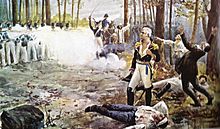Liniers Counter-revolution facts for kids

Execution of Santiago de Liniers
|
|
| Date | May-July 1810 |
|---|---|
| Location | Córdoba Province (Argentina) |
| Participants | Santiago de Liniers and other royalists from Córdoba |
| Outcome | Counter-revolution failed, leaders executed. Córdoba supports the Primera Junta |
The Liniers Counter-Revolution was an event that happened in 1810. It took place in the Viceroyalty of the Río de la Plata, which was a large Spanish colony in South America. This happened right after the May Revolution, when people in Buenos Aires started to seek independence from Spain.
Santiago de Liniers, who used to be the leader (viceroy) of the colony, tried to stop this revolution. He gathered people in the city of Córdoba to fight against the new government in Buenos Aires. This attempt failed quickly. The new government had formed an army called the Army of the North. This army stopped Liniers and his supporters.
The leader of the Army of the North, Francisco Ortiz de Ocampo, captured Liniers and the other leaders. He sent them as prisoners to Buenos Aires. However, the new government, called the Primera Junta, gave a different order. They wanted the leaders to be executed before they reached the city. So, Liniers and his allies were put to death.
Contents
Why the Uprising Started
On May 25, 1810, the old leader of the colony, Baltasar Hidalgo de Cisneros, was removed from power. This was part of the May Revolution. A new government, the Primera Junta, took his place in Buenos Aires. This new government asked other cities in the colony to join them and send their own representatives.
Liniers was living in Córdoba at this time. The old viceroy, Cisneros, sent him instructions. He told Liniers to prepare to fight against the revolution. Cisneros gave Liniers full power to do this.
Córdoba's Decision
A meeting was held in Córdoba with important people. These included Liniers, the bishop Rodrigo de Orellana, and the governor Juan Gutiérrez de la Concha. They decided to take up arms and fight against the revolution in Buenos Aires. Only one important person, the Dean Gregorio Funes, supported the actions of Buenos Aires.
The people who supported the Spanish king (called royalists) thought they had a good chance to win. Other parts of the colony, like Paraguay, did not recognize the new government. Montevideo was also getting ready to act against Buenos Aires. Plus, Spanish armies from the north, led by Goyeneche and Nieto, could send strong help. If Córdoba could hold out, the new government might have failed.
The Junta's Response
The new government in Buenos Aires, the Primera Junta, decided to act fast. They knew they had to stop the uprising in Córdoba right away. Ortiz de Ocampo prepared an army and marched towards Córdoba. His first orders from the Junta were to capture the leaders.
Later, the Junta sent a new order. This order asked for the death of the people leading the uprising. Many people think this order came from Mariano Moreno, a key member of the Junta. However, all members of the Junta signed it, except for Manuel Alberti. He was a religious leader and could not agree to the death penalty.
No Battle in Córdoba
There was no big fight in Córdoba. The soldiers Liniers had gathered either left or simply disappeared. Liniers was left alone. He tried to escape to the north to join other Spanish armies. But Ocampo managed to capture him and the other leaders.
Ocampo did not execute them right away. He sent them as prisoners to Buenos Aires, following his first orders. Dean Gregorio Funes had also asked for their lives to be spared.
The Final Order
Mariano Moreno was not happy that the prisoners were still alive. He worried that Liniers was too famous. He thought Liniers being a prisoner, or even being executed in Buenos Aires, could cause big problems.
So, Moreno asked another member of the Junta, Juan José Castelli, to stop the group of prisoners. Castelli was told to take control of the army and carry out the execution order. By this time, the bishop Orellana was spared from the death sentence. Castelli reached the prisoners in time. He ordered them to be put to death without a trial at a place called Cabeza de Tigre. This was a stop on the way to Buenos Aires, in southeastern Córdoba.
After the Uprising
Once the uprising was stopped, the government in Córdoba was changed. All the people who supported the Spanish king were removed. Pueyrredón was named the new governor. A meeting of important citizens (called an open cabildo) then chose Funes as the representative for Córdoba, as the Junta had asked. The army then continued its march north, starting the First Alto Perú campaign.
See also
In Spanish: Contrarrevolución de Córdoba para niños

